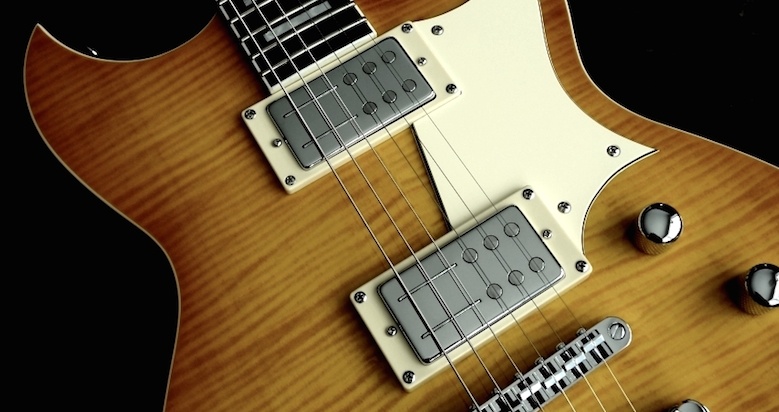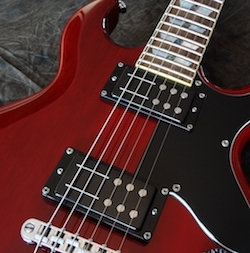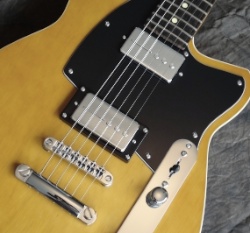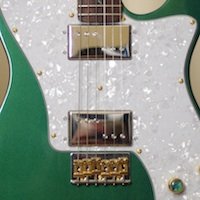The magnetic attraction of Railhammer pickups
There are few components of a guitar which have more influence over the tone than the pickup. Yet few guitar players understand how they're made. We spoke to Joe Naylor of Railhammer to find out.

The dark art of pickup winding is a mystery to many of us and while we might know whether we prefer the snap of a single coil to the crunch of a humbucker, few could talk about these critical components in any great detail.
Who better, then to interrogate on the business of poles and magnets than Railhammer's Joe Naylor. We started by asking him how he got started.
'Pickups were intriguing to me because there's so many different ways to make a good one,' explained Joe. 'I learned the basics of pickup winding at the Roberto-Venn School of Luthiery in Phoenix, which I attended in 1987. After that I built my own pickup winder out of an electric drill motor and some bicycle parts. It was a pretty cool machine, it wound three strat pickups at the same time! I sold it to somebody after I started Naylor amps.'
With that kind of machinery at his disposal, Naylor was off and running. 'My first wind was at Roberto-Venn. It was a large single-coil and it was pretty crude. First you'd wind a coil on a motor, then remove the coil and wrap it in tape... no bobbin, it looked like a small plastic donut when it was done. Then you'd take that and drop a large ceramic magnet in the middle, with no metal polepieces at all, the magnet was the polepiece. That assembly was then dropped into a wood pickup cover, and the cover filled with Bondo. Crude and unusual, but they looked and sounded great!'

An entrepreneur at heart – Joe started Naylor Amps and then Reverend Guitars – starting a pickup company seemed like an obvious move. We wanted to know what makes Railhammer pickups different from the competition. 'The big feature is the patent pending rail/pole structure' explained Joe, patriently. 'Thin rails under the wound strings sense a narrower section of string, reducing note smearing and muddiness, for a tighter sound. Oversize poles under the plain strings sense a wider section of string, increasing thickness and sustain, producing a fatter sound. Now the wound strings sound tighter, and the plain strings sound fatter, which makes the overall EQ spectrum more balanced.'
Warming to the chance to talk about one of his favourite subjects, and sensing we were keen to know more, Naylor continued. 'You can dial in your amp for a tight percussive tone without the plain strings sounding thin, or dial in a fat tone without the wound strings turning to complete mush. Even on the neck pickup you can play heavy riffs and complex chords with clarity, and make harmonics pop with ease. When you play lead on the plain strings and move up to the high frets, the tone stays thick and punchy.'
And there's more: 'finally, the dynamic response is enhanced because of the very efficient magnet/pole structure, and no moving parts, both of which increase the pickup's sensitivity to string movement. So it's not just about the rail/pole EQ thing, all Railhammers also have touch sensitivity, sustain, and harmonic content that is enhanced beyond normal.'
OK. So now we now what makes Railhammers special, but what about the rest of us? How do we make the perfect pickup? 'Test, revise, test, revise,' explained Joe, wisely. 'Repeat until perfect. Making a good sounding pickup is not that hard to do. Making a unique pickup that nails that exact sound you hear in your head? That requires a LOT of time and effort, you have to be willing to put in the work, and it might take years.'
Years? Hmm. What about buying pickups then, what should guitar players look for? 'Don't be overly concerned with technical specifications. For example, all alnico pickups don't sound vintage, and all ceramic pickups don't sound modern. A designer can manipulate the tone endlessly by changing the wire gauge, number of winds, shape of the coils, type of polepieces, type of cover, etc. For example, the standard humbucker I designed for Reverend guitars is ceramic, but most people think it's alnico after playing it. The Seymour Duncan JB is a legendary heavy rock/metal pickup, and it's alnico. I always tell people, don't judge a pickup by the magnet type, judge it by the product description, and ultimately with your ears.'
As for Railhammer's own pickups, Naylor explained that his greatest satisfaction was 'gaining acceptance in the mainstream. It's a radical design, but I feel it's also a very practical design that really works, and offers advantages any serious guitar player can appreciate.'
And now that it has acceptance and its pickups are available internationally, including in the US at Musicians Friend and Stewart-MacDonald, we wanted to know what's next.

'We recently launched the H90 series, which are P90 style in a standard humbucker size cover. We offer the Gnarly 90 for the vintage P90 tone, and the Tel 90 which is a tonal hybrid between a P90 and Tele pickups.
The next new model will be a signature humbucker set with Bob Balch from Fu Manchu. He's a fuzz riff-master in a legendary band, and we've cooked up something special for him, so look for that soon.'
We can't wait to see, and hear that Bob Balch humbucker.
More pickups on Guitar Hive...
Oil City Pick-ups

'I love it when people send me pics of their builds or sound clips … I’m a big kid at heart I guess. I’ve gone to gigs where I know the artist is using my pickups and I have a big grin, ear to ear the whole time.' Ash from Oil City Pick-ups tells us his story.
Read the full interview with Ash here.

Recently on Guitar Hive
-
Electric guitar strings - make your next set the best you've ever played
Apr 23, 15 02:06 PM
There are so many different types and brands of electric guitar strings on the market, buying a set can be confusing. Here's how to choose the best set for you. -
The guitar neck – types, profiles, and everything else you wanted to know
Apr 17, 15 02:24 PM
The guitar neck is the most personal part of the instrument. No wonder it comes in so many shapes and types. -
The neck fingerboard radius explained
Apr 15, 15 06:01 AM
The neck fingerboard radius is one of those seemingly complicated features that's really very easy to understand.
On eBay...




New! Comments
Have your say about what you just read! Leave us a comment in the box below.